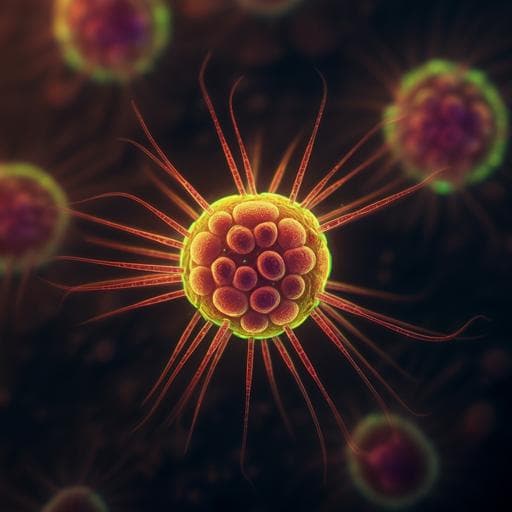
Biology
Unlocking the potentials of cyanobacterial photosynthesis for directly converting carbon dioxide into glucose
S. Zhang, J. Sun, et al.
Discover how researchers Shanshan Zhang, Jiahui Sun, Dandan Feng, Huili Sun, Jinyu Cui, Xuexia Zeng, Yannan Wu, Guodong Luan, and Xuefeng Lu have unlocked the potential of Synechococcus elongatus PCC 7942 for photosynthetic glucose production. By engineering metabolic pathways, they achieved remarkable glucose accumulation and secretion, showcasing the innovative capabilities of cyanobacteria.
~3 min • Beginner • English
Introduction
Glucose is a central metabolite that provides energy and carbon skeletons via glycolytic pathways (EMP, OPP, ED) and is a key feedstock for biorefineries. Industrial glucose supply predominantly relies on processing plant/algal biomass, whose feasibility is affected by cultivation cycles, logistics, and pretreatment costs. In the context of climate change and food security challenges, more efficient and continuous glucose production routes are desirable. Although various non-photosynthetic routes (chemical–biochemical, electrocatalytic–biological, and in vitro enzymatic cascades) have achieved direct CO2-to-glucose or glucose polymer synthesis, continuous photosynthesis-linked glucose production has not been realized. In phototrophs, glucose metabolism tightly interacts with photosynthesis and pigment metabolism, and excess glucose can inhibit photosynthetic activity; thus, glucose rarely accumulates. Cyanobacteria can be engineered to synthesize and secrete sugars (e.g., sucrose, trehalose), but direct photosynthetic glucose production remains limited. This study aims to engineer Synechococcus elongatus PCC 7942 to convert CO2 directly and stably into secreted glucose by identifying and relieving the intracellular bottlenecks that restrict glucose synthesis and export.
Literature Review
Prior efforts have achieved CO2-to-glucose or glucose polymer formation through artificial routes (e.g., chemical–biochemical hybrids, electrocatalytic–biological systems, in vitro enzyme cascades), but continuous, photosynthesis-coupled glucose production has not been demonstrated. In cyanobacteria, genetic manipulation has enabled secretion of compatible solutes and sugars (sucrose, trehalose), generally linked to osmotic stress responses. Reports of glucose secretion in cyanobacteria are scarce and often constrained by environmental triggers; for example, deletion of phosphoketolase (xpk) in PCC 7942 led to glucose secretion only under dark and salt stress, at low titers (~3 mM) and requiring very high cell densities. Background on glucose metabolism in phototrophs indicates complex regulatory interactions with photosynthesis that deter overaccumulation. Collectively, literature suggests that (i) glucose rarely accumulates in phototrophic metabolism, (ii) sucrose pathways function as stress responses but can be engineered for secretion, and (iii) unlocking direct glucose production likely requires overcoming native consumption and regulatory ‘floodgates’ such as glucokinase activity.
Methodology
- Strain engineering: Two glucokinase genes (glk1: Synpcc7942_0221; glk2: Synpcc7942_2111) were targeted for knockout in Synechococcus elongatus PCC 7942 to block phosphorylation of glucose and its entry into EMP/OPP pathways. Knockouts were constructed in both wild-type (WT) and recombinant backgrounds carrying a heterologous glucose transporter (GalP). Homozygous double knockouts were isolated through multiple passages with antibiotic selection; spontaneous mutations emerged in some lines during acclimation.
- Additional genetic modifications: To trace glucose origin via sucrose metabolism, invertase (invA, Synpcc7942_0397) and sucrose-phosphate synthase (sps) were individually knocked out in glucokinase-deficient backgrounds. A heterologous sucrose permease (CscB/Scb) was expressed to export sucrose and probe sucrose flux. Further transporter engineering and overexpression of sucrose-pathway enzymes were tested. A spontaneous SNP (G274A) in Synpcc7942_1161 identified by whole-genome sequencing was functionally validated by knockout, allele replacement, and overexpression.
- Cultivation conditions: Batch cultures in BG11 medium at 30 °C under varying illumination (100–200 μmol photons m−2 s−1) and carbon supply (air vs 3% CO2). Some experiments used modified BG11 without citrate/ferric amine citrate; 2× BG11 was tested for process optimization. Fed-batch-like resuspension with fresh medium every 12 h was used to prolong production.
- Analytical assays: Extracellular and intracellular glucose quantified by enzymatic kits (Megazyme) and ion chromatography (Dionex IC5000+). Intracellular metabolites extracted with 80% ethanol. Glucokinase activity measured via enzyme-linked assays using NADP+ coupling with G6PDH. Isotope labeling experiments with inorganic carbon tracers evaluated carbon source incorporation into glucose. Oxygen evolution and respiration measured to assess photosynthetic activity.
- Omics: Whole-genome resequencing (Illumina HiSeq) of engineered strains to identify SNPs/structural variants; verification by Sanger sequencing. Transcriptomics (RNA-seq; differential expression with FPKM, p-adj < 0.05 and |log2FC| ≥ log2(1.5)) to assess global remodeling. Untargeted metabolomics by UHPLC-MS/MS with data processing (XCMS) and pathway mapping (KEGG). mRNA stability assays for Synpcc7942_1161 variants using ActD chase and qRT-PCR.
- Protein biochemistry: Heterologous expression and purification of Glk1, Glk2, and Fbp in E. coli; enzyme activity assays for glucokinase/fructokinase on various substrates using PK/LDH-coupled assays.
- Comparative genomics: HMMER searches for glucokinase homologs across cyanobacterial genomes to contextualize gene distributions.
Key Findings
- Knocking out both glucokinases (glk1 and glk2) enabled extracellular glucose accumulation and secretion in Synechococcus elongatus PCC 7942 without introducing heterologous catalytic enzymes. Homozygous double knockouts were more readily isolated in a strain carrying GalP; isolation in WT required prolonged passages, suggesting adaptive mutations are beneficial.
- Under enhanced illumination and carbon supply (200 μmol photons m−2 s−1; 3% CO2), glucokinase-deficient strains secreted substantial glucose: S23 reached ~1.64 g/L and S217 ~1.16 g/L. Glucose accumulation tracked biomass increase, indicating active production by living cells. Intracellular glucose also increased markedly (e.g., S23 ~5.6 mg/L per OD730 on day 6; S217 ~2.5 mg/L per OD730).
- Isotope labeling demonstrated that secreted glucose originated directly from photosynthetically fixed inorganic carbon; removing citrate/ferric amine citrate from medium minimally affected labeling and production.
- Sucrose metabolism is the dominant source of glucose: Knockouts of invertase (invA) or sucrose-phosphate synthase (sps) in glucokinase-deficient backgrounds reduced glucose secretion by ~90%, implicating sucrose biosynthesis and hydrolysis as main contributors. Expression of a sucrose permease (CscB/Scb) led to continuous sucrose secretion (to ~350 mg/L in 8 days) and reduced intracellular sucrose without affecting glucose, confirming a sustained sucrose flux independent of salt stress.
- A spontaneous SNP (G274A) in Synpcc7942_1161 (resulting in V92I) was identified in a high-secreting double-glucokinase knockout strain. Disruption of Synpcc7942_1161 reduced glucose secretion by ~78% to ~0.33 g/L, demonstrating its key role in export. Overexpression increased transcript abundance and glucose secretion, suggesting the mutation enhances transcription/functional abundance rather than mRNA stability; data are consistent with the transporter favoring glucose efflux (WT with mutant allele did not import glucose).
- Global remodeling accompanied secretion: 581 genes were differentially expressed in the secreting strain (227 up, 354 down; p < 0.01 enrichment in photosynthesis and oxidative phosphorylation). Metabolomics showed intracellular sucrose increased by ~74% and fructose increased ~8-fold, indicating strong sucrose hydrolysis and a fructose-processing bottleneck.
- Process and metabolic engineering improved titers: Baseline secretion from glucokinase deficiency and spontaneous mutation reached ~1.5 g/L; with further metabolic/cultivation optimization, glucose titers improved to around 5 g/L. Using 2× BG11 increased S2R3 titers from ~2.0 to ~2.9 g/L, and fed-batch resuspension every 12 h prolonged production. Overexpression of fructokinase decreased glucose secretion, likely due to non-specific phosphorylation restoring a glucose-phosphate cycle.
- Transporter engineering facilitated phenotype acquisition: Introducing a heterologous glucose transporter in some backgrounds alleviated intracellular stress and enabled easier isolation of double knockouts; however, glucokinase deficiency also appeared to activate native/alternative glucose export routes.
Discussion
The study addresses the long-standing barrier to direct, continuous glucose production via photosynthesis in cyanobacteria by identifying glucokinase as a key ‘floodgate’ that prevents glucose accumulation. By disabling glucokinase activity, intracellular glucose generated via active sucrose metabolism escapes recapture by phosphorylation and can be secreted. Contrary to the conventional view that sucrose metabolism primarily functions as a salt-stress-induced protective route, results show that a sucrose synthesis–hydrolysis cycle operates robustly under non-stress conditions and can be tapped for glucose formation. The discovery of a spontaneous SNP in Synpcc7942_1161 that promotes glucose export underscores transporter control as a critical determinant of secretion and explains the protracted selection needed to obtain homozygous double knockouts in WT backgrounds. Systems-level changes in gene expression and metabolite pools reflect a substantial metabolic rewiring to accommodate high-level glucose secretion, including increased sucrose turnover and a fructose processing bottleneck. Collectively, these findings demonstrate that rerouting photosynthetically fixed carbon into secreted glucose is feasible in a stable, light-driven manner without heterologous catalytic pathways, and that combining metabolic, transporter, and cultivation engineering can substantially elevate titers.
Conclusion
This work establishes a direct photosynthetic route to glucose in Synechococcus elongatus PCC 7942 by eliminating native glucokinase activity and leveraging an active sucrose metabolism cycle. Glucose secretion reached ~1.5 g/L through glucokinase deficiency and a spontaneous transporter-related SNP, and improved to ~5 g/L via additional metabolic and cultivation engineering. The data reveal that glucokinase functions as a central control point preventing glucose overaccumulation and that sucrose biosynthesis/hydrolysis can drive glucose formation independently of salt stress. Insights into transporter contributions (Synpcc7942_1161 mutation, heterologous transporters) and global metabolic remodeling provide a framework for designing robust, continuous CO2-to-glucose production systems. Future work should (i) elucidate the precise identity and kinetics of glucose export systems, (ii) balance fructose utilization to avoid bottlenecks, (iii) optimize growth–production trade-offs, and (iv) scale fed-batch or continuous photobioreactor processes for industrial application.
Limitations
- Growth and photosynthetic performance were perturbed in glucokinase-deficient strains, indicating a trade-off between production and cellular fitness; increased sensitivity to salt (e.g., 150 mM NaCl) was observed.
- Residual glucokinase-like activity likely exists (e.g., from non-specific kinases), complicating full control over glucose recycling.
- Glucose export relies in part on spontaneous mutation (Synpcc7942_1161 G274A) or transporter engineering; the native export mechanism and transporter specificity remain incompletely characterized.
- Sucrose-derived fructose accumulated strongly, revealing a downstream bottleneck that can reduce carbon efficiency; attempts to relieve it (e.g., fructokinase overexpression) can inadvertently decrease glucose secretion by restoring phosphorylation cycles.
- Reported titers depended on relatively high light and CO2 and specific media optimizations; robustness across industrially relevant conditions and long-term genetic stability require further validation.
Related Publications
Explore these studies to deepen your understanding of the subject.







